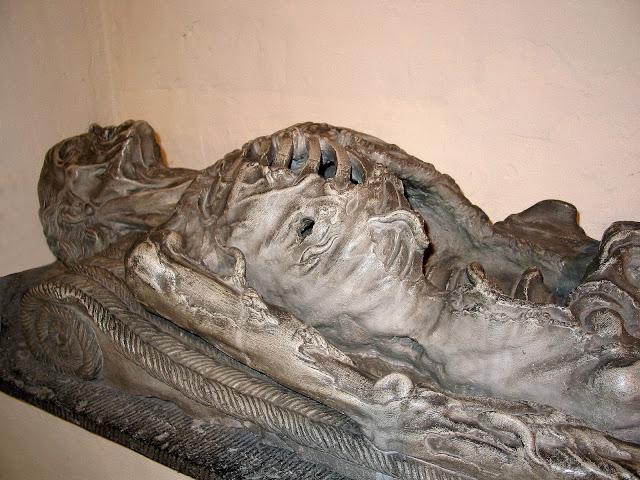Thursday, January 4, 2024
Vanitas
Wednesday, December 27, 2023
The Corpses of the DeWitt Brothers by Jan de Baen. 1672 - 1675.
Tuesday, December 26, 2023
Sunday, December 17, 2023
Saint Victoria's incorruptible body
Albrecht Durer's three Meisterstiche "master prints"
Melencolia I is a large 1514 engraving by the German Renaissance artist Albrecht Dürer. Its central subject is an enigmatic and gloomy winged female figure thought to be a personification of melancholia – melancholy. Holding her head in her hand, she stares past the busy scene in front of her. The area is strewn with symbols and tools associated with craft and carpentry, including an hourglass, weighing scales, a hand plane, a claw hammer, and a saw. Other objects relate to alchemy, geometry or numerology. Behind the figure is a structure with an embedded magic square, and a ladder leading beyond the frame. The sky contains a rainbow, a comet or planet, and a bat-like creature bearing the text that has become the print's title.
Knight, Death and the Devil is a large 1513 engraving by the German artist Albrecht Dürer. A stolid armoured knight on a proud horse, accompanied by his faithful dog, rides through a wild narrow gorge flanked by a goat-headed devil and the figure of death riding a pale horse. Death's rotting corpse holds an hourglass, a reminder of the shortness of life. The rider moves through the scene looking away from the creatures lurking around him, and appears almost contemptuous of the threats, and is thus often seen as symbol of courage; the knight's armour, the horse which towers in size over the beasts, and the oak leaves are symbolic of the resilience of faith, while the knight's plight may represent Christians' earthly journey towards the Kingdom of Heaven symbolized by the city on the hill.
Saint Jerome in His Study is a copper engraving of 1514 by the German artist Albrecht Dürer. Saint Jerome is shown sitting behind his desk, engrossed in work. The table, on the corner of which is a cross, is typical of the Renaissance. An imaginary line from Jerome's head passing through the cross would arrive at the skull on the window ledge, as if contrasting death and the Resurrection. The lion in the foreground is part of the traditional iconography of St. Jerome, and near it is a sleeping dog, an animal found frequently in Dürer's works, symbolizing loyalty.
Jerome is also often depicted with a lion, in reference to the popular hagiographical belief that Jerome had tamed a lion in the wilderness by healing its paw.
The positioning of the Crucifix on Jerome's desk is such that when he looks at it he can also see the skull by the window. Looking at the crucifix reminds of the resurrection of Jesus, which righted the wrongs of Adam leading to death, represented by the skull. The hourglass represents the finite space of time that is a man's life. Viewing these symbols together leads to the thought of man's mortality, and the method by which to save the immortal soul.
Saturday, December 16, 2023
The Moretta Mask - void mask
The moretta mask, reserved exclusively for women, was a Venetian mask that was round and covered with black velvet. Also known as the 'muta', it perfectly concealed the features of the wearer's face and was very common in Venice in the 18th century.
Giovanni Grevembroch, who penned wonderful descriptions of Venetian costumes, wrote this in the 18th century:
“The heads of the family and the husbands led the wives and the sons to the Piazza [S. Marco], […] had her face covered by a black moretta, which created such contrast to the whiteness of the flesh that it shone, making it highly visible.”
Covering one's face in order to appear more attractive ('visible') may seem like a contradiction, but it was not so according to the special logic of Venetian women. These women were rather disinhibited in showing their bodies, as evidenced by the fashion called “décolleté alla veneziana”, famous throughout Europe. It featured a very generous, square neckline. The breast was veiled in a light fabric, which covered the chest precariously. It was also common to put makeup on the nipples with carmine red so as to make them more 'visible' behind the transparent fabric.
Polish pulpits shaped like the whale that swallowed Jonah
Anna Morandi
In Morandi’s 18th-century Bologna, it would have been unusual, to say the least, to watch a woman so unflinchingly peel back the skin of a human body. Yet Morandi did just that, even drawing the praise of the Bolognese Pope’s for her efforts to reveal the secrets of vitality and sensation concealed beneath the skin. Working at the delicate intersection of empirical science and the artistic rendering of the human body, Morandi helped elevate her city as a hub of science and culture.
As an anatomist, Morandi went where no woman had gone before, helping to usher in a new understanding of the male body and developing new techniques for examining organs. She also served as the public face of an unusual scientific partnership with her husband, a sculptor and anatomist. Yet in one way, she was no exception to what has become a common narrative of historical women in science: Despite her achievement and acclaim during her lifetime, her role was ultimately written out of history.
Retrato doble (double portrait) by Matthäus Merian, 1616.
Non sum sicut caeteri homines.
(I am not like other people.)
Dives sum et locupletatus et nullius egeo.
(I am rich and enriched, and I have need of no one.)
Ecce ad nihilum redactus sum, et nescivi.
(Behold, I am reduced to nothing, and I did not know.)
Quam miser et miserabilis pauper caecus et nudus essem.
(How wretched and pitiful, blind and naked I was.)



























